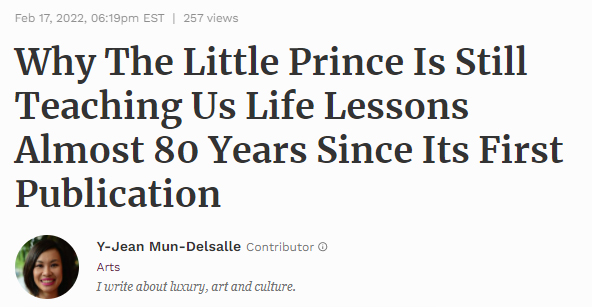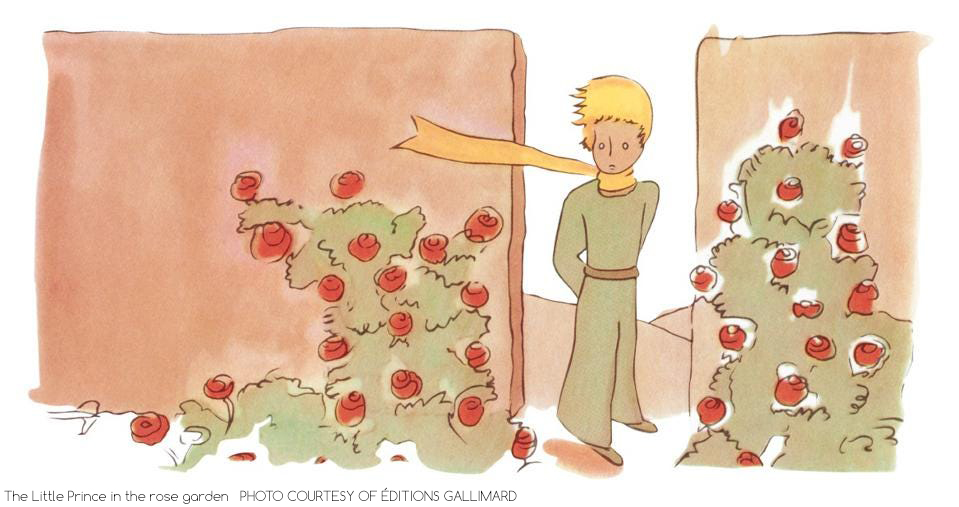

Just as the Museum of Decorative Arts in Paris opens “An Encounter with the Little Prince”, the first major museum show in France dedicated to the literary masterpiece written by Antoine de Saint-Exupéry in New York during World War Two, the touring exhibition “The Little Prince Among Humans” organized by Tempora gets ready to launch next week at Brussels Expo in Belgium, following its successful premiere in Lyon, France. Both exhibitions run until the end of June 2022. I sit down with Olivier d’Agay, great-nephew of the illustrious French author-pilot and secretary-general of the Antoine de Saint-Exupéry Youth Foundation, to learn about the timelessness of The Little Prince, which continues to tackle the great issues of today, close to eight decades after its first release.

Among Antoine de Saint-Exupéry’s literary oeuvre as a whole, what is the place of The Little Prince?
The place of The Little Prince in his work is both central and unique. It is central because it is the best-known work. It is the most translated book in the world (480 languages) and the number of editions and copies sold worldwide (more than 200 million) has been countless. Unique because this literary object does not resemble a novel or the rest of his work. The form is rather like a tale, supposedly for children, but which is in fact addressed to adults (who have not forgotten their childhood). Its success is due as much to the watercolors painted by the author himself as the text. The author does not present it as his testament, but it contains the quintessence of his experiences on earth and his philosophy. It should be remembered that Antoine de Saint-Exupéry published very little during his lifetime – six books – and that just as many posthumous works were “produced” after his death over a period of 70 years, including The Wisdom of the Sands, based on his numerous manuscripts that were preserved after his disappearance on July 31, 1944. The Little Prince, which was commissioned by his American publisher (Antoine de Saint-Exupéry was in New York at the time, between 1941 and 1943, before going off to war in North Africa), started out as a nice project to pay the bills and became, through the miracle of my great-uncle’s inspiration and genius, the most universal, timeless and modern fable, which has spoken to people for nearly 80 years (1943-2023). In terms of style, and I’m not talking about the drawings, which are more the graphic work of Antoine de Saint-Exupéry than literary, perfection has been achieved, and quotes from the book have traveled around the world: “It is only with the heart that one can see rightly; what is essential is invisible to the eye” or “To me, you will be unique in all the world”, etc.
Why has The Little Prince become one of the most important French literary works in the world, translated into close to 500 different languages and dialects, and a bestseller almost 80 years after its first publication?
The reasons for the success of the Little Prince are its power and its usefulness. Its circulation was slow but very progressive. There were three main periods in the propagation of the text. Between 1943 and 1960, the major languages took hold of it, enabling large linguistic communities to discover its existence and share it: English, Spanish, Portuguese, French, German, Japanese, Chinese, Italian and Russian. Then each country had its own translation, from Greek to Korean, as well as Arabic and Swedish between 1960 and 1980. Then came the numerous regional languages in Europe (more than 50), Africa, India and the Soviet Union. Finally, since 1980, we have seen the appearance of translations in indigenous languages (Inuit, Inca, Berliner, Aramaic, Creole, Quechua), in specialized languages (Braille, Volapük, Esperanto) and in dead or imaginary languages (hieroglyphics, Latin, ancient Greek, Klingon). In short, everyone had access to the work and the phenomenon of propagation could be amplified because it is a book with which we want to share the pleasure of reading and its benefits with our entourage. Word of mouth worked fantastically well. The Little Prince is a book that you pass on to your children, grandchildren, friends and loved ones. It is first and foremost a book that consoles the loss of a loved one; there are millions of testimonies in this sense. It is also a guide and a survival manual in this absurd world (in the Camusian sense of the term) for those who doubt or wonder about the meaning of life, death and relationships between individuals. It is an esoteric book that brings real answers to these questions if we know how to read between the lines. We can speak of three levels of reading for The Little Prince: that of the story, that which the author wanted to hide in his story and that of our interpretation. The Little Prince has the power of poetic seduction, enchantment and healing. It has the power to bring us serenity and hope. It is of capital use for each one of us. Therefore, it is useful and advisable to reread it frequently.
READ THE REST OF THIS INTERVIEW AT: FORBES.COM
